
Dec 7
Coffee Weekly Report - 2023 12 07
Back to main blog page
- Coffee prices are volatile nearing December contract expiration, influenced by changes in arabica ICE rules and low destination stocks.
- Concerns focus on Brazil's 24/25 crop, with recent warm weather impacting conilon production. Espírito Santo, main conilon state, has an ONI Index below 2015 levels, which preceded a 30% production drop.
- Despite a lower ONI Index, El Niño brings stronger anomalies in November 2023 with temperatures 9°C higher and precipitation 75mm below the November 2015 average.
- Contrasting 2015 and 2023 weather patterns show more negative vegetation conditions in 2015, not only in Espírito Santo but also in other coffee-producing regions.
- For the next few weeks, caution is needed regarding the weather: the maintenance of higher temperatures and below-average rainfall can harm yields and reduce the potential seen until October in Espírito Santo.
El Niño’s impact in conilon areas
Coffee prices have been more volatile as we approach the expiration of the December contract, in the middle of changes to the arabica ICE certification rules and historically low destination stocks.
Concerns are now turning towards the 24/25 crop in Brazil, as the recent warm weather has been attributed as the cause behind chumbinhos falling in coffee areas, especially for conilon.
Looking at Espírito Santo, the main conilon-producing state, there are some points to consider.
First, it’s important to note that the ONI Index has not reached the same levels as seen in 2015 during development (Figure #1) – prior to the 30% drop in production observed (from 15.3M bags in 15/16 to 10.7M bags in 16/17, considering that the 15/16 crop was already weakened by weather issues).
Usually, the phenomenon leads to warmer temperatures and lower rainfall levels in the region during the last two months of the year (Figure #2).
Image 1: ONI Index – ENSO Status (°C)
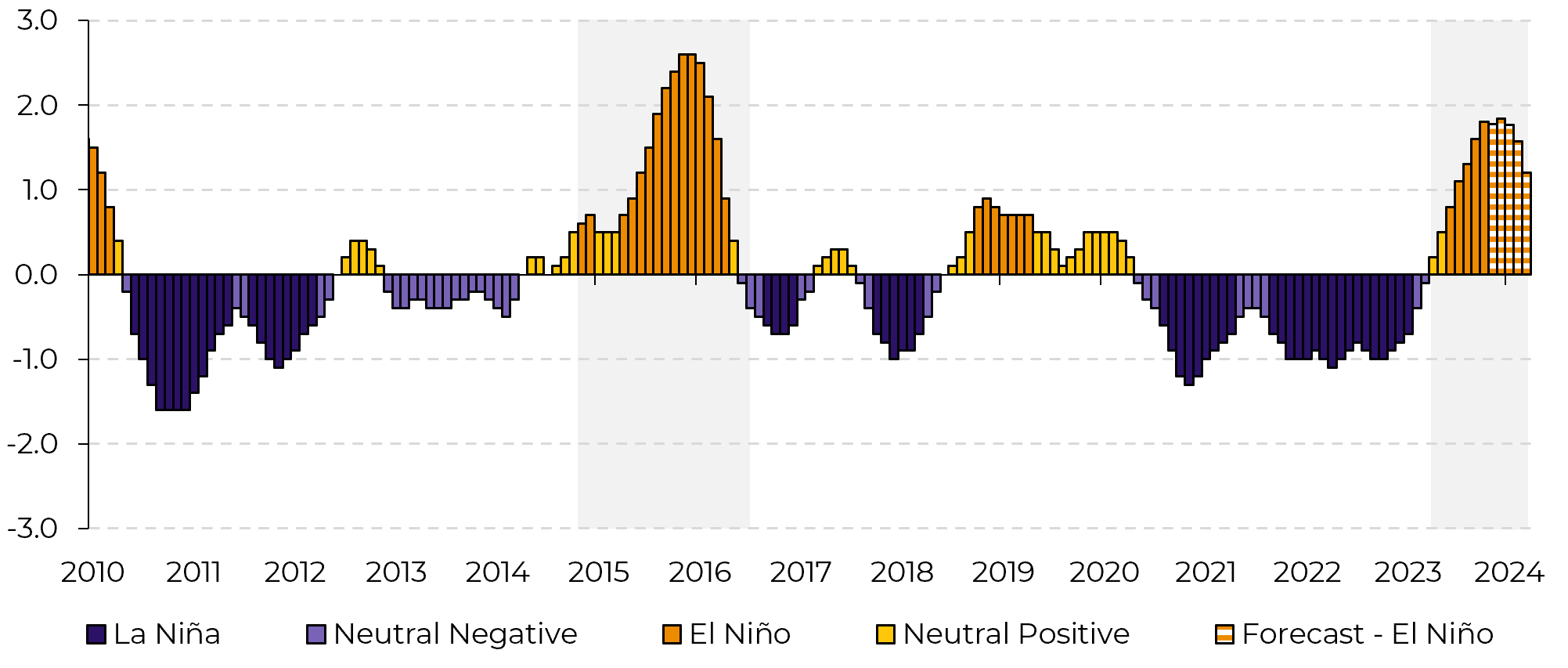
Source: NOAA
Image 2: November-December El Niño Anomalies
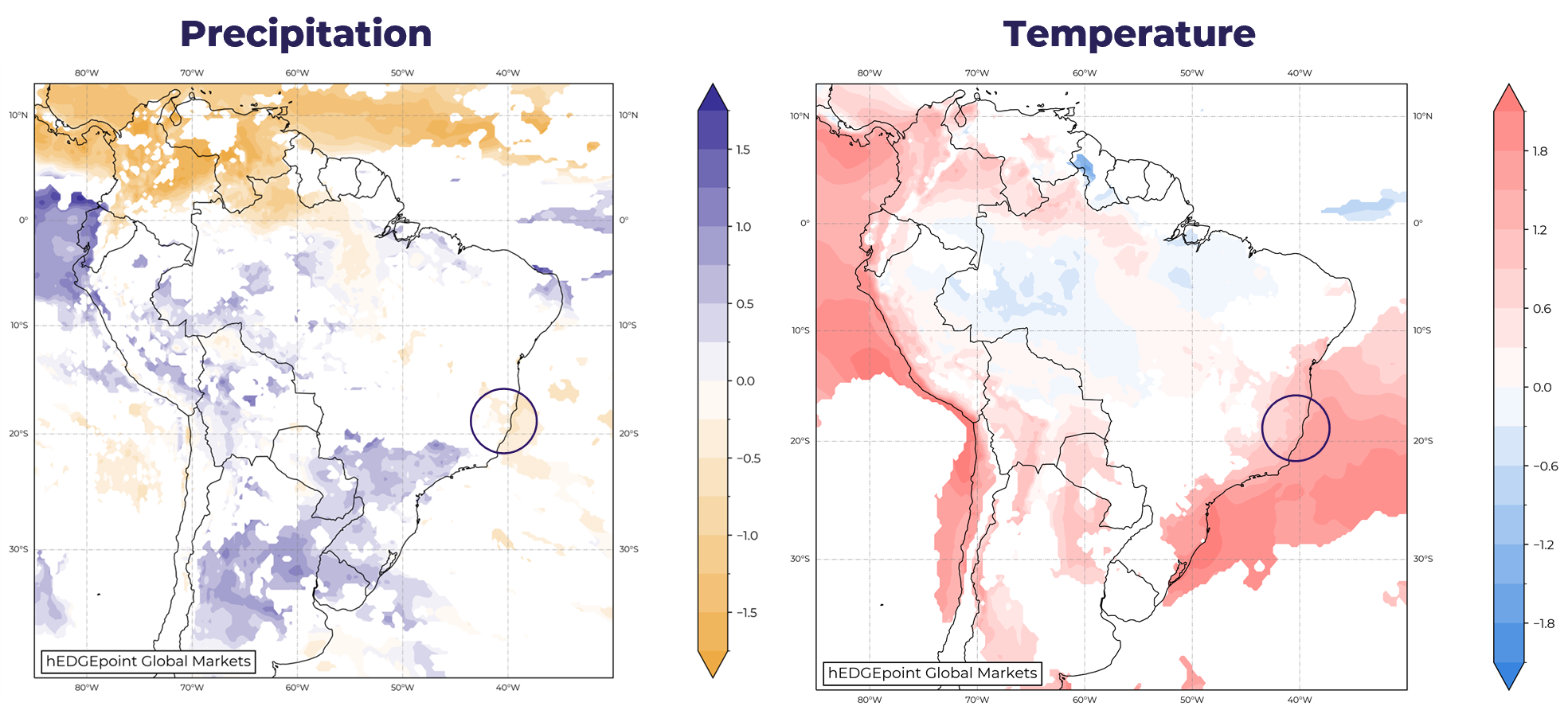
Source: hEDGEpoint
In addition to other global impacts of climate change, the El Niño phenomenon has brought more intense anomalies, despite the lower ONI Index. Comparing November 2023 to the historical average, maximum temperatures have been higher than normal by 9°C (Figure #3), and monthly precipitation has been 75mm below average (Figure #4) – and the observed levels are also more severe than those seen in 2015.
Image 3: Maximum Temperature Anomaly (°C)
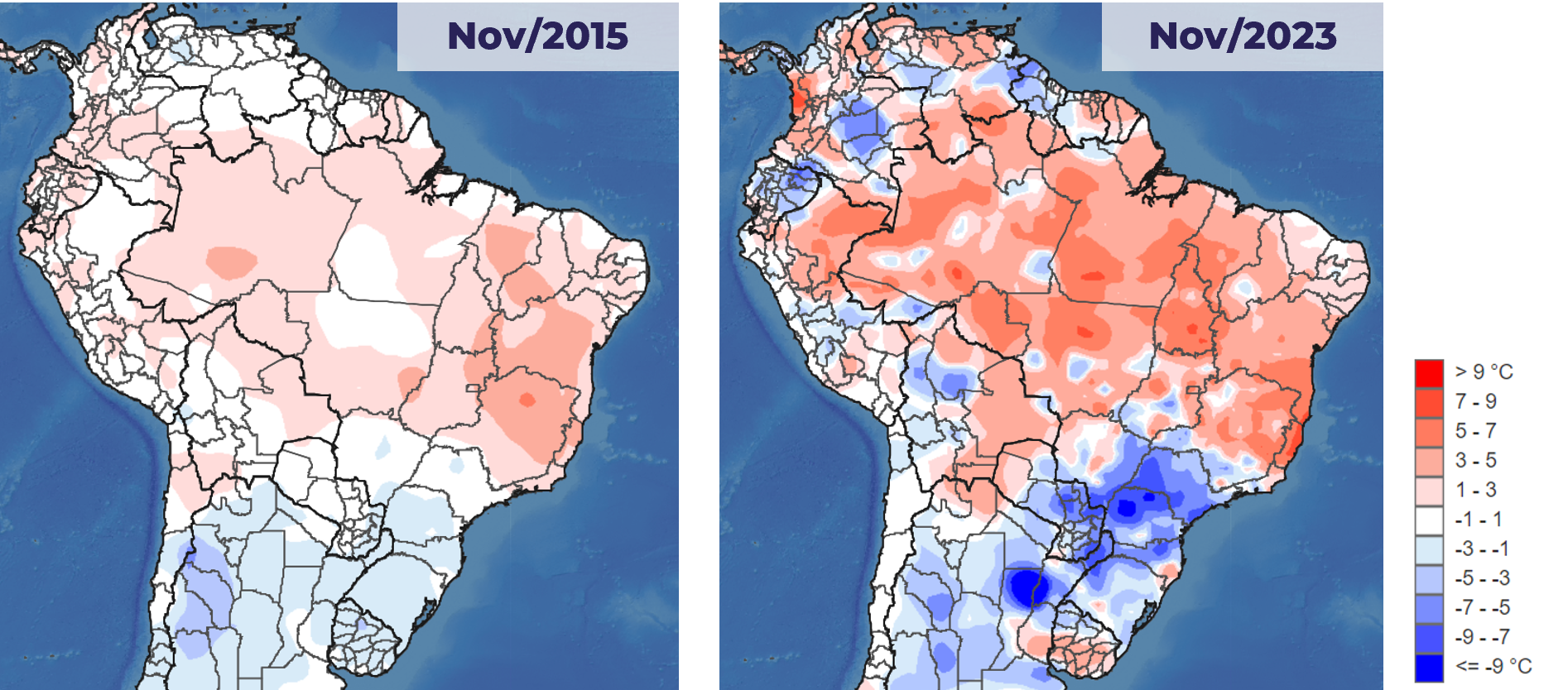
Source: USDA
Image 4: Precipitation Anomaly (mm)
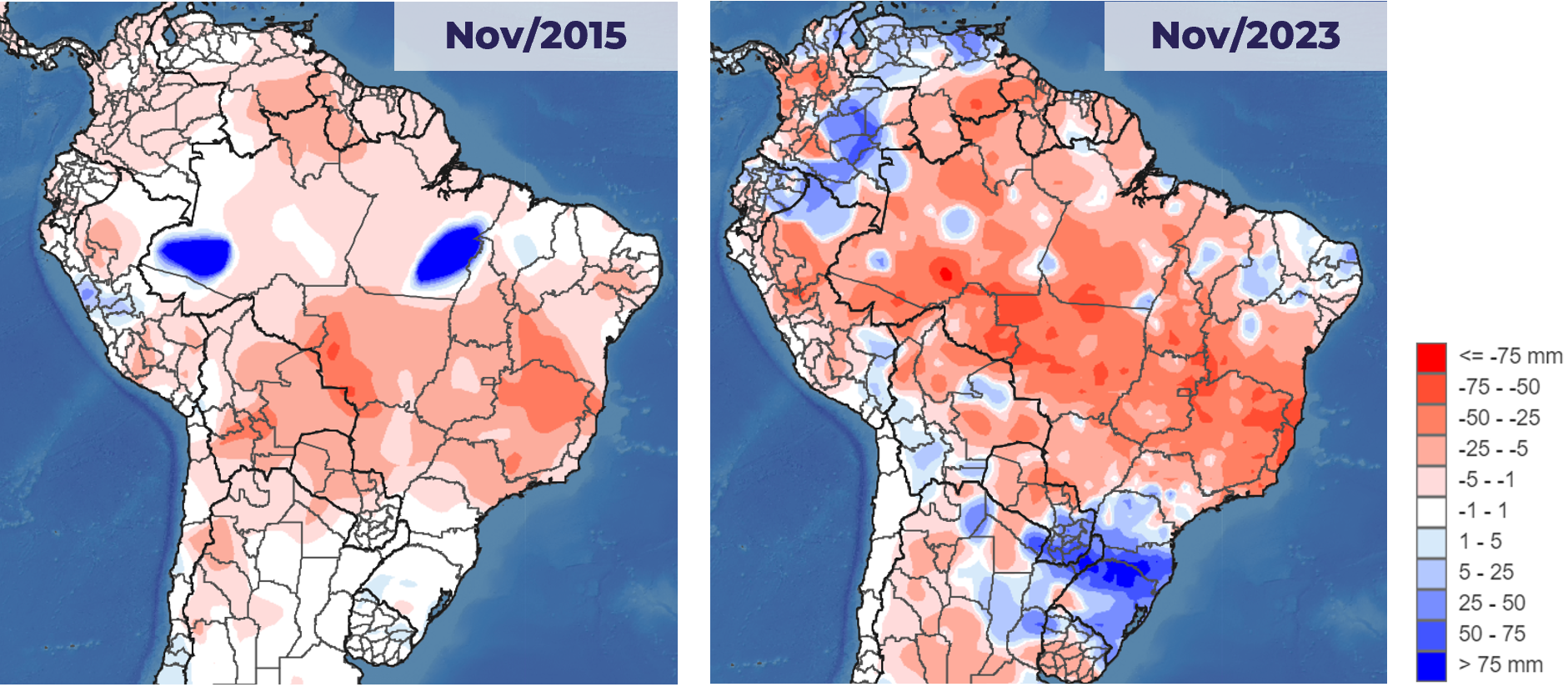
Source: USDA
Image 5: NDVI Anomaly – First week of December
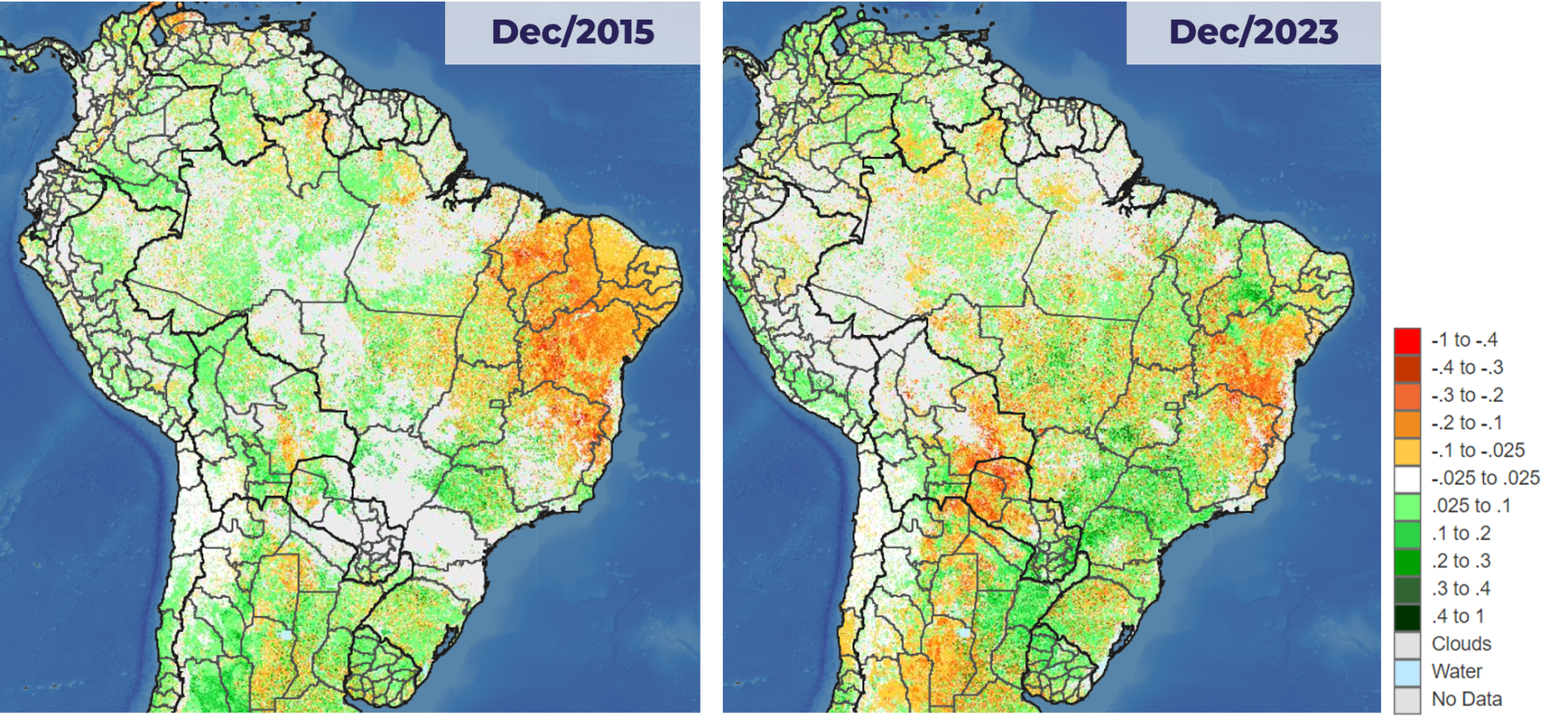
Source: USDA
However, there are two points to be considered in contrast to the weather patterns.
i) Vegetation conditions
In 2015, since the El Niño phenomenon had already been active for a longer period, the crop was already weakened, and the NDVI levels were worse in the first week of December when compared to 2023. This is also true for other coffee-producing regions, such as Minas Gerais, São Paulo, and Paraná (Figure #5).
ii) Area increase
Given the conilon producer margins observed in 2021, there was an incentive for area expansion in the region. Margins were higher in that year when compared to the other periods since 2018 (Figure #6).
Consequently, the area expansion observed since 2021 (Figure #7) would reach average production potential in the next 2-3 years, placing 24/25 as a key point in time.
Consequently, the area expansion observed since 2021 (Figure #7) would reach average production potential in the next 2-3 years, placing 24/25 as a key point in time.
Image 6: Conilon Prices/Production Costs Ratio
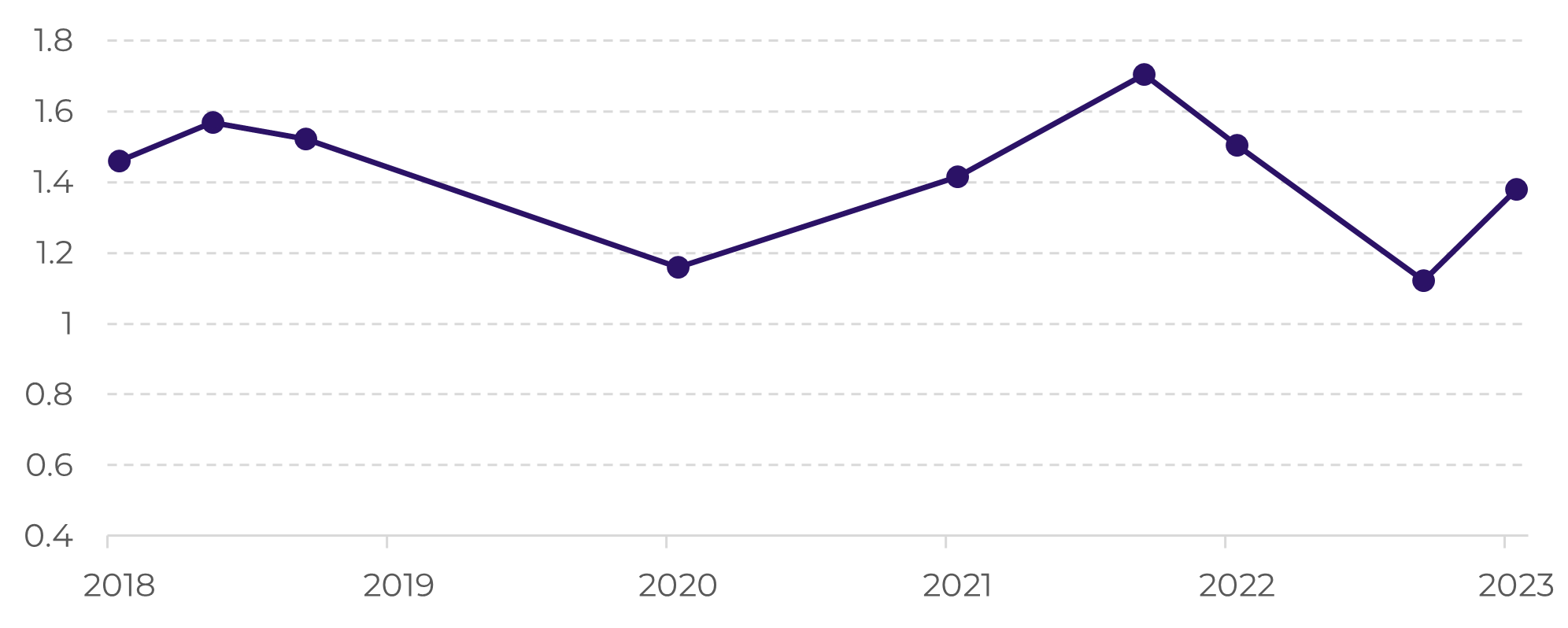
Fonte: Cepea, Conab
Image 7: Conilon Total Area – Conab (‘000 ha)
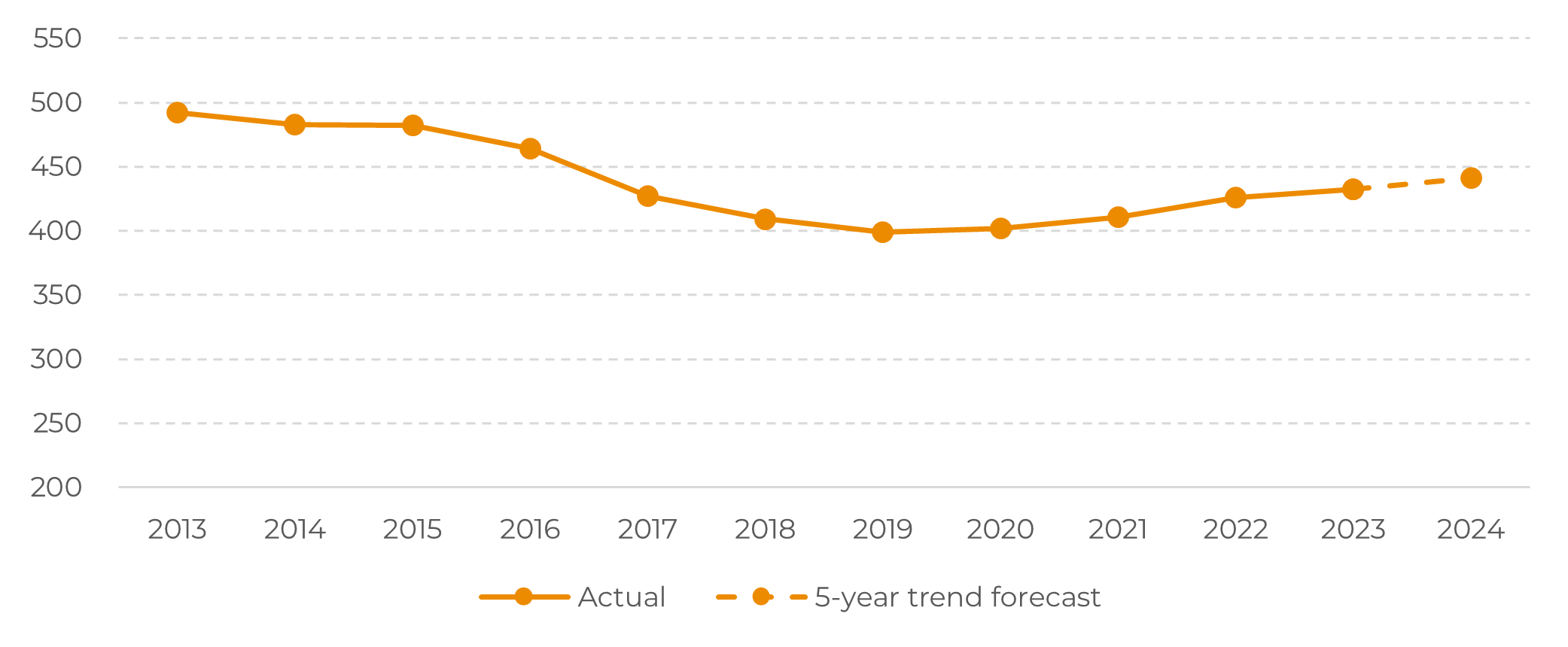
Fonte: Conab
In Summary
Coffee prices are experiencing increased volatility due to the approaching expiration of the December contract, changes in arabica ICE certification rules, and historically low destination stocks. Concerns now focus on Brazil's 24/25 crop, with recent warm weather affecting coffee areas, particularly conilon.
Examining Espírito Santo, the primary conilon-producing state, the ONI Index hasn't reached 2015 levels, which preceded a 30% production drop. Despite a lower ONI Index, El Niño has caused stronger anomalies, with November 2023 temperatures 9°C higher and precipitation 75mm lower than average.
Contrasting climate patterns, vegetation conditions in 2015 were more negative, and the increase in area was also significant in recent years.
Still, for the next few weeks, caution is needed regarding the weather: the maintenance of higher temperatures and below-average rainfall can harm yields and reduce the potential seen until October in Espírito Santo.
Weekly Report — Coffee
Written by Natália Gandolphi
natalia.gandolphi@hedgepointglobal.com
natalia.gandolphi@hedgepointglobal.com
Reviewed by Lívea Coda
livea.coda@hedgepointglobal.com
www.hedgepointglobal.com
Disclaimer
This document has been prepared by hEDGEpoint Global Markets LLC and its affiliates ("HPGM") exclusively for informational and instructional purposes, without the purpose of creating obligations or commitments with third parties, and is not intended to promote an offer, or solicitation of an offer, to sell or buy any securities or investment products. HPGM and its associates expressly disclaim any use of the information contained herein that may result in direct or indirect damage of any kind. If you have any questions that are not resolved in the first instance of contact with the client (client.services@hedgepointglobal.com), please contact our internal ombudsman channel (ouvidoria@hedgepointglobal.com) or 0800-878-8408 (for clients in Brazil only).
Contact us
hedgepointhub.support@hedgepointglobal.com
ouvidoria@hedgepointglobal.com
Funchal Street, 418, 18º floor - Vila Olímpia São Paulo, SP, Brasil
Check our general terms and important notices.
This page has been prepared by Hedgepoint Schweiz AG and its affiliates (“Hedgepoint”) solely for informational and instructional purposes, without the purpose of instituting obligations or commitments to third parties, nor is it intended to promote an offer, or solicitation of an offer of sale or purchase relating to any securities, commodities interests or investment products. Hedgepoint and its associates expressly disclaim any use of the information contained herein that directly or indirectly result in damages or damages of any kind. Information is obtained from sources which we believe to be reliable, but we do not warrant or guarantee the timeliness or accuracy of this information. The trading of commodities interests such as futures, options, and swaps involves substantial risk of loss and may not be suitable for all investors. You should carefully consider wither such trading is suitable for you in light of your financial condition. Past performance is not necessarily indicative of future results. Customers should rely on their own independent judgement and/or advisors before entering in any transaction.Hedgepoint does not provide legal, tax or accounting advice and you are responsible for seeking any such advice separately.Hedgepoint Schweiz AG is organized, incorporated, and existing under the laws of Switzerland, is filiated to ARIF, the Association Romande des Intermédiaires Financiers, which is a FINMA-authorized Self-Regulatory Organization. Hedgepoint Commodities LLC is organized, incorporated, and existing under the laws of the USA, and is authorized and regulated by the Commodity Futures Trading Commission (CFTC) and a member of the National Futures Association (NFA) to act as an Introducing Broker and Commodity Trading Advisor. HedgePoint Global Markets Limited is Regulated by the Dubai Financial Services Authority. The content is directed at Professional Clients and not Retail Clients. Hedgepoint Global Markets PTE. Ltd is organized, incorporated, and existing under the laws of Singapore, exempted from obtaining a financial services license as per the Second Schedule of the Securities and Futures (Licensing and Conduct of Business) Act, by the Monetary Authority of Singapore (MAS). Hedgepoint Global Markets DTVM Ltda. is authorized and regulated in Brazil by the Central Bank of Brazil (BCB) and the Brazilian Securities Commission (CVM). Hedgepoint Serviços Ltda. is organized, incorporated, and existing under the laws of Brazil. Hedgepoint Global Markets S.A. is organized, incorporated, and existing under the laws of Uruguay. In case of questions not resolved by the first instance of customer contact (client.services@Hedgepointglobal.com), please contact internal ombudsman channel (ombudsman@hedgepointglobal.com – global or ouvidoria@hedgepointglobal.com – Brazil only) or call 0800-8788408 (Brazil only).Integrity, ethics, and transparency are values that guide our culture. To further strengthen our practices, Hedgepoint has a whistleblower channel for employees and third-parties by e-mail ethicline@hedgepointglobal.com or forms Ethic Line – Hedgepoint Global Markets.Security note: All contacts with customers and partners are conducted exclusively through our domain @hedgepointglobal.com. Do not accept any information, bills, statements or requests from different domains and pay special attention to any variations in letters or spelling, as they may indicate a fraudulent situation.“HedgePoint” and the “HedgePoint” logo are marks for the exclusive use of HedgePoint and/or its affiliates. Use or reproduction is prohibited, unless expressly authorized by HedgePoint. Furthermore, the use of any other marks in this document has been authorized for identification purposes only. It does not, therefore, imply any rights of HedgePoint in these marks or imply endorsement, association or seal by the owners of these marks with HedgePoint or its affiliates.
We have updated our Terms & Conditions to reflect improvements to our platform, data handling practices, and the overall experience we provide to our clients.
To continue using the Hedgepoint HUB, please review and accept the updated terms.

